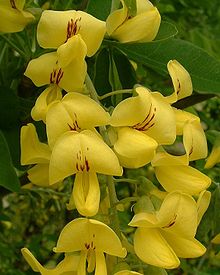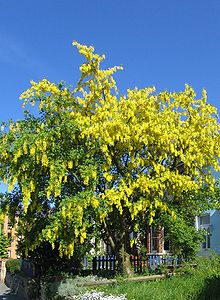- Laburnum
-
For the suburb of Melbourne, see Laburnum, Victoria.
- "Indian laburnum" is the golden shower tree, a distant relative of the genus Laburnum.
Laburnum 
Common laburnum – flowers Scientific classification Kingdom: Plantae (unranked): Angiosperms (unranked): Eudicots (unranked): Rosids Order: Fabales Family: Fabaceae Subfamily: Faboideae Tribe: Genisteae Genus: Laburnum
Fabr.Species Laburnum anagyroides
Laburnum alpinumLaburnum (commonly called golden chain) is a genus of two species of small trees in the subfamily Faboideae of the pea family Fabaceae, Laburnum anagyroides (common laburnum) and L. alpinum (alpine laburnum). They are native to the mountains of southern Europe from France to the Balkan Peninsula. Some botanists include a third species, Laburnum caramanicum, but this native of southeast Europe and Asia Minor is usually treated in a distinct genus Podocytisus, more closely allied to the brooms.
The trees are deciduous. They have yellow pea-flowers in pendulous racemes 10–30 cm (4–12 in) long in spring, which makes them very popular garden trees. In L. anagyroides, the racemes are 10–20 cm (4–8 in) long, with densely packed flowers; in L. alpinum the racemes are 20–30 cm (8–12 in) long, but with the flowers sparsely along the raceme.
The leaves are trifoliate, somewhat like a clover; the leaflets are typically 2–3 cm (0.8–1.2 in) long in L. anagyroides and 4–5 cm (1.6–2.0 in) long in L. alpinum.
Most garden specimens are of the hybrid between the two species, Laburnum × watereri (Voss's laburnum), which combines the longer racemes of L. alpinum with the denser flowers of L. anagyroides; it also has the benefit of low seed production. Laburnum seed can poison anyone who mistakes the seeds for peas.
The yellow flowers are responsible for the old poetic name 'golden chain tree' (also spelled golden chaintree or goldenchain tree).
All parts of the plant are poisonous, and can be lethal if consumed in excess. Symptoms of laburnum poisoning may include intense sleepiness, vomiting, convulsive movements, coma, slight frothing at the mouth and unequally dilated pupils. In some cases, diarrhea is very severe, and at times the convulsions are markedly tetanic. The main toxin in the plant is cytisine, a nicotinic receptor agonist. It is used as a food plant by the larvae of some Lepidoptera species, including the buff-tip.
The heart-wood of a laburnum may be used as a substitute for ebony or rosewood, very hard and a dark chocolate brown, with a butter-yellow sapwood.
Uses
Laburnum has historically been used for cabinetmaking and inlay, as well as for musical instruments. In addition to such wind instruments as recorders and flutes, it was a popular wood for Great Highland bagpipes[1] before taste turned to imported dense tropical hardwoods such as cocuswood, ebony, and African blackwood.[2]
Cultural references
In the TV mystery series Mother Love, Helena (Diana Rigg) muses over what plant she should use to poison a pair of children and chooses the laburnum, saying, "Laburnum! Such a pretty tree – and so many of them!"
Sylvia Plath referred to the image of the laburnum tree and "its blond colonnades" in her poem "The Arrival of the Bee Box", first published posthumously in the collection Ariel (1965).
Oscar Wilde referred to laburnum in his novel, The Picture of Dorian Gray, noting the "...honey-sweet and honey-coloured blossoms of a laburnum...".
In Richmond and continuing into Henrico County, Virginia, Laburnum Avenue is one of the main thoroughfares. The street is lined with many laburnum trees.
In W. W. Jacobs' short story "The Monkey's Paw", the name of the house of the family is "Laburnum Villa", suggesting that the house is not as safe and protective as initially described.
In the Doctor Who serial "The Mark of the Rani", the Sixth Doctor suggests that if the Master turned into a tree, it would be a laburnum, because they have poisonous pods.
The novel A Melon for Ecstasy by John Fortune and John Wells is, in part, about the main character's forbidden love affair with the laburnum in his back yard.
Laburnum seeds are the agent of suspected poisoning in the Daphne du Maurier novel My Cousin Rachel.
In Redwall novel Triss, the secret entrance to Brockhall is between an ash tree and a laburnum tree.
In Ted Hughes poem "The Laburnum Top," the central character goldfinch sits and feeds its young ones on this tree.
In Wizardborn, the third book in Dave Wolverton's (David Farland} The Runelords series, Averan, the Earth Warden, chooses her staff of power from the wood of the laburnum tree.
In "The Hobbit" by "J.R.R. Tolkien", Bilbo Baggins recalls Gandalf's "...particularly excellent fireworks...They used to go up like great lilies and snapdragons and laburnums of fire and hang in the twilight all evening."
References and external links
- ^ B. J. Rendle (March 1969). World Timbers: Europe and Africa. E. Benn. p. 40. http://books.google.com/books?id=JIhGAAAAYAAJ. Retrieved 29 April 2011.
- ^ Joshua Dickson (9 October 2009). The Highland bagpipe: music, history, tradition. Ashgate Publishing, Ltd.. pp. 50–. ISBN 9780754666691. http://books.google.com/books?id=JOfk2YpundEC&pg=PA50. Retrieved 29 April 2011.
- Flora Europaea: Laburnum
- ILDIS Legume Database
- time lapse video of a year in the life of a laburnum tree.
- Grieve, 'A Modern Herbal' (1931)
Categories:
Wikimedia Foundation. 2010.

